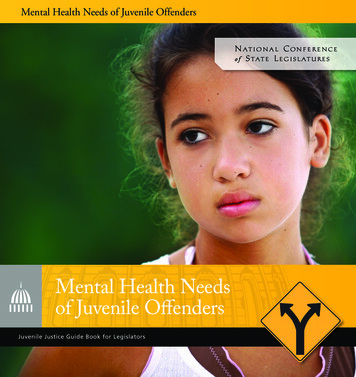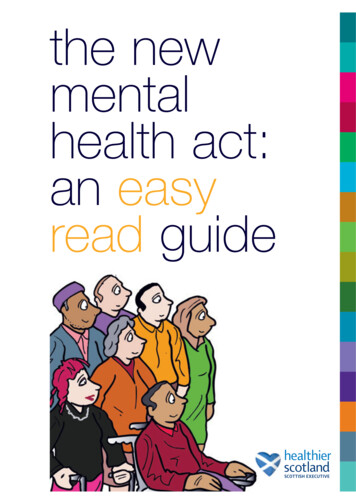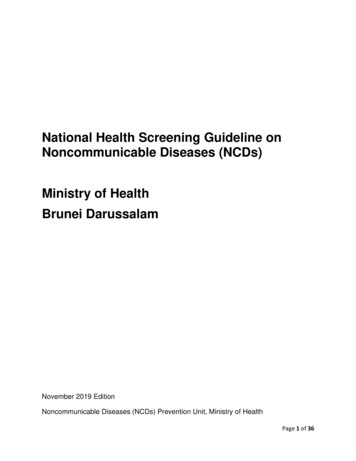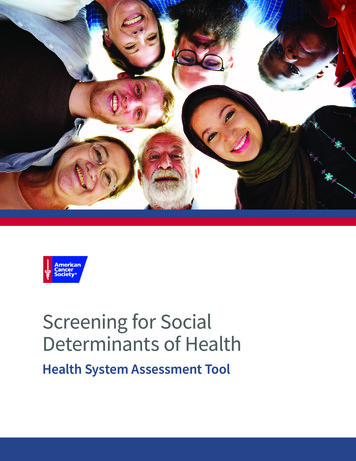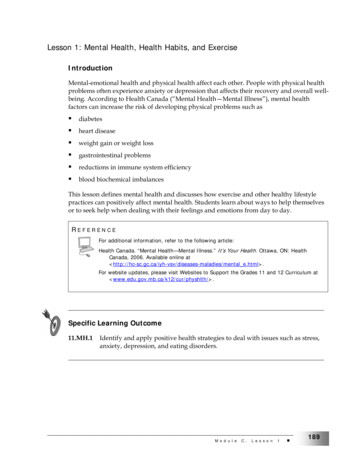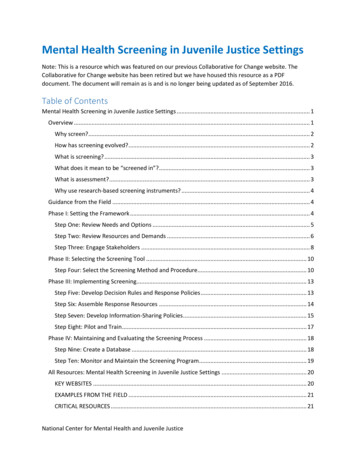
Transcription
Mental Health Screening in Juvenile Justice SettingsNote: This is a resource which was featured on our previous Collaborative for Change website. TheCollaborative for Change website has been retired but we have housed this resource as a PDFdocument. The document will remain as is and is no longer being updated as of September 2016.Table of ContentsMental Health Screening in Juvenile Justice Settings . 1Overview . 1Why screen?. 2How has screening evolved? . 2What is screening? . 3What does it mean to be “screened in”? . 3What is assessment? . 3Why use research-based screening instruments? . 4Guidance from the Field . 4Phase I: Setting the Framework . 4Step One: Review Needs and Options . 5Step Two: Review Resources and Demands . 6Step Three: Engage Stakeholders . 8Phase II: Selecting the Screening Tool . 10Step Four: Select the Screening Method and Procedure. 10Phase III: Implementing Screening. 13Step Five: Develop Decision Rules and Response Policies . 13Step Six: Assemble Response Resources . 14Step Seven: Develop Information-Sharing Policies . 15Step Eight: Pilot and Train . 17Phase IV: Maintaining and Evaluating the Screening Process . 18Step Nine: Create a Database . 18Step Ten: Monitor and Maintain the Screening Program . 19All Resources: Mental Health Screening in Juvenile Justice Settings . 20KEY WEBSITES . 20EXAMPLES FROM THE FIELD . 21CRITICAL RESOURCES . 21National Center for Mental Health and Juvenile Justice
Assorted Resources on Mental Health and Juvenile Justice . 22CRITICAL RESOURCES . 22National Center for Mental Health and Juvenile Justice
Mental Health Screening in Juvenile Justice SettingsThe majority of youth who come into contact with the juvenile justice system have a diagnosable mentalor substance use disorder. In fact, many youth are experiencing both. Combinations of mental illnessand substance use are often referred to as either behavioral health problems or co-occurring issues.One of the most important steps in responding to the behavioral health treatment needs of youth in thejuvenile justice system is to systematically identify these needs as youth become involved with thesystem. The development of sound screening and assessment capacity is critical to effectively identifyand ultimately respond to mental illness and substance use disorders. With the development over thelast 10-15 years of easy-to-use screening tools, many designed to be used by non-clinical staff, the fieldhas taken a major step forward in responding to the behavioral health needs of youth in the system.An overview of screening, accompanied by a four-phase, ten-step guide generated from input by thejuvenile justice field, is presented below. This ten-step guide draws heavily from Dr. Thomas Grisso’swork on screening. Each of the steps includes resources for juvenile justice professionals andadministrators, behavioral health partners, and other stakeholders seeking to implement screening. Theresources are organized – when applicable – into three categories: key websitesexamples from the field (best practices and model policies suitable for adaptation or replication)critical resources (guides, reports on critical issues, and most recent research)OverviewOver the last decade, there has been a steady increase in the awareness of the unmet needssurrounding mental illness and substance use disorder among youth in the juvenile justicesystem. Evidence suggests more than half of all youth in contact with the juvenile justicesystem have a diagnosable mental or substance use disorder. Many are experiencing both. Prevalence studies have consistently found that 60-70 percent of youth in the juvenile justicesystem meet criteria for mental health disorders (Shufelt & Cocozza, 2006).A large, national, multisite study found that 16 percent of youth at juvenile justice intake, 40percent at pretrial detention, and 47 percent in youth corrections met criteria for a substanceuse disorder (Wasserman, McReynolds, Schwalbe, Keating, & Jones, 2010).The majority of youth with a mental disorder also have a substance use disorder (Shufelt &Cocozza, 2006; Wasserman, McReynolds, Schwalbe, Keating, & Jones, 2010).About 27 percent of justice-involved youth have disorders that are serious enough to requireimmediate and significant treatment (Shufelt & Cocozza, 2006).SCREENING VERSUS ASSESSMENTScreening is a relatively brief process often carried out by non-clinical staff to triage and identifyyouth whose mental or emotional condition suggests that they might have a behavioral healthdisorder.National Center for Mental Health and Juvenile Justice1
Assessments, typically conducted by professionals with specialized training in clinicalassessment, are generally more time consuming than screening and often involve discussionwith youth’s parents, clinical and structured interviews, assessment tools, and review of pastrecords.Why screen?One of the most important steps for responding to the behavioral health issues of youth in thejuvenile justice system is to systematically identify the needs of youth as they become involvedwith the juvenile justice system (Skowyra & Cocozza, 2007). In order to do this, behavioralhealth screening measures and procedures must be in place to identify mental illness andsubstance use disorder needs among youth at their earliest point of contact with the system.How has screening evolved?Only in recent years has reliable evidence about the prevalence of mental illness and substanceuse disorders among youth in the juvenile justice system become available. Looking back only adecade or two reveals how much things have changed.In the early 1990s, behavioral health screening within the juvenile justice system was virtuallynonexistent, as documented in the monograph, Responding to the Mental Health Needs ofYouth in the Juvenile Justice System (Cocozza, 1992). Much has changed in the field since therelease of that report. Awareness of the needs of these youth has steadily increased, stirringpublic interest and governmental efforts to respond to what has been widely identified as acrisis (Grisso, Vincent, & Seagrave, 2005). These efforts to respond have led to: More and better constructed researchGreater advocacy for behavioral health screening within juvenile justice systems and programsAvailability of scientifically sound behavioral health screening toolsBehavioral health screening within juvenile justice programs is quickly becoming the rule ratherthan the exception. Nearly every state in the country is now implementing behavioral healthscreening measures within some major systems in juvenile justice programs. The issues thathave now surfaced are generally more complex – often involving multiple systems andrequiring clarification to allow the field to refine its efforts and to continue its progress.In April 2015, the National Center for Juvenile Justice (NCJJ) released a state-by-state scan onMental Health Screening in Juvenile Justice as part of its Juvenile Justice GPS (Geography, Policy,Practice & Statistics) project. This publication summarizes NCJJ’s survey of all 50 states todetermine how mental health screening is conducted in juvenile probation, detention, andcorrectional systems. The survey also looked at whether screening is required by statute orpolicy and which instruments are used.National Center for Mental Health and Juvenile Justice2
What is screening?Screening is typically a brief procedure conducted by non-clinical staff using one or morestandardized tools. Screening is a triage process that is employed with every youth to identifythose with mental or emotional conditions that suggest a behavioral health disorder, suicidepotential, or risk of harm to others in the immediate future.What does it mean to be “screened in”?The term “screened in” is often used to refer to youth who are identified by the screeningmethod as requiring further attention (i.e., might have serious needs). Being “screened in” on ascreening tool does not mean that a youth actually has a diagnosable mental disorder,substance use disorder, or significant risk of harming him/herself or someone else. It meansonly that further follow-up is warranted to determine the presence of a suspected condition.Follow-up steps triggered by being “screened in” may include: Managing an urgent risk of harmObtaining a higher level of clinical careReferring for further assessmentFailing to be “screened in” usually means that there is relatively low risk that the youth hasproblems serious enough to require more intense intervention.What is assessment?When a youth is “screened in,” access to assessment must occur in a timely manner.Assessments are typically conducted by professionals with specialized training in clinicalassessment. They are generally more time consuming than screening protocols, often involvingdiscussions with youth’s parents, clinical or structured interviews, use of assessment tools, andreviews of past records. The clinician tailors assessment methods to the individual case or thenature of the problem suggested by the screening.Assessments provide a more detailed description of: The youth’s historyClinical needsFunctioning across several domains (e.g., family, peers, school)Risk and protective factorsRecommendations for management or treatmentNational Center for Mental Health and Juvenile Justice3
Why use research-based screening instruments?Screening tools should be backed by research that establishes their measurement dependability(reliability) and whether they actually measure the symptoms or problems they claim tomeasure (validity). When they are supported in this way, they are referred to as “researchbased” tools. Choosing a tool that has been demonstrated by research to be reliable and validand then using the tool exactly as it was used in the research leads to confidence that the tool isproviding reliable results about what it is supposed to measure. If there is no evidence that thescreening method dependably measures the psychological conditions or psychiatric symptomsthat it is intended to identify, time and resources are likely to be wasted.Guidance from the FieldThe guidelines below are applicable to a wide array of jurisdictions and states seeking todevelop or improve screening services for juvenile justice-involved youth who may beexperiencing behavioral health disorders.The four phases and ten steps of Behavioral Health Screening in Juvenile Justice Settings weredeveloped by Dr. Thomas Grisso of the National Youth Screening & Assessment Project (NYSAP)and Dr. Robert Kinscherff of the National Center for Mental Health and Juvenile Justice(NCMHJJ). These guidelines are not meant to imply that the implementation process is alwayslinear, with one step following another; rather, it is to lay out the landscape of activities ascomprehensively and clearly as possible.Additional guidance came from the collaboration of eight states that were competitivelyselected to participate in the John D. and Catherine T. MacArthur Foundation and theSubstance Abuse and Mental Health Services Administration (SAMHSA) initiative entitledImproving Diversion Policies and Programs for Justice-Involved Youth with Co-Occurring Mentaland Substance Use Disorders: An Integrated Policy Academy/Action Network Initiative. Six ofthe eight states (Arkansas, Michigan, Minnesota, Mississippi, South Carolina, and Virginia)committed to improving policies and programs for screening youth with co-occurring disorders. Phase I: Setting the FrameworkPhase II: Selecting the Screening ToolPhase III: Implementing ScreeningPhase IV: Maintaining and Evaluating ScreeningPhase I: Setting the FrameworkThe first phase of developing screening establishes why, what, and who: Why is the screening program necessary?National Center for Mental Health and Juvenile Justice4
What resources will contribute to development and what demands will challenge development?Who will be involved in the screening program and its development?Responding to these questions will provide structure to the development process, as well asestablish common expectations for the screening program.The steps for Phase I are: Step One: Review Needs and OptionsStep Two: Review Resources and DemandsStep Three: Engage StakeholdersStep One: Review Needs and OptionsThe first step in establishing screening is twofold: to develop a clear rationale for behavioralhealth screening and to review options regarding available screening methods.Identify Reasons for Behavioral Health ScreeningDeveloping a clear, concise view of the program’s need for behavioral health screening is valuable for atleast two reasons: When reasons for screening are explicitly stated and justified, critical stakeholders are morelikely to engage in the initiative.A statement of needs will guide the selection of screening methods. Tools vary in format andcontent, so it is important to choose the screening tool that is best suited to address programneeds.Review Behavioral Health Screening OptionsWhile it is premature at this point to actually select a screening tool or method, it is helpful toidentify two or three of the most pressing needs for behavioral health screening to help narrowthe many screening tool options. As listed below, there are several ways in which screeningtools differ. All of these items should be considered during the review and selection process.1. Format (e.g., paper and pencil; computer-administered/scored)2. Content (e.g., single-scale versus multiple scales; scales focusing on symptoms versus on socialproblem areas)3. Length (e.g., number of items)4. Time required for administration and scoring5. Training required to administer (e.g., minimal in-service training; training to become certified)6. Administration cost (e.g., cost of manual only; fee per case)7. Evidence base (e.g., quality and extent of research establishing reliability and validity)Reasons for Behavioral Health ScreeningNational Center for Mental Health and Juvenile Justice5
Identifying youth who may have behavioral health problems before they worsenIdentifying youth with behavioral health problems that require immediate attentionIdentifying youth who present an imminent risk of suicide or self-injuryKEY WEBSITESThe Global Appraisal of Individual Needs (GAIN) Coordinating Center originated in 1993 as acollaborative effort between clinicians, researchers, and policymakers to create acomprehensive and standardized biopsychosocial assessment tool.The National Youth Screening & Assessment Project (NYSAP) is a technical assistance andresearch center dedicated to helping juvenile justice programs identify youths’ needs forbehavioral health intervention and risk management. NYSAP developed the MassachusettsYouth Screening Instrument (MAYSI), which is currently the most widely used mental healthscreening tool in juvenile justice programs nationwide.EXAMPLES FROM THE FIELDThe Louisiana Juvenile Justice System Screening, Assessment & Treatment Services Inventorywas designed to provide a local planning board with an inventory of the screening andassessment procedures and existing services and programs available in its parish.Mental Health Screening and Assessment in the Illinois Juvenile Justice System discusses theidentification of mental health problems, how mental health screening and assessmentpractices are being used in the Illinois juvenile justice system, and what mental health screeningand assessment tools are available.CRITICAL RESOURCESGrisso, T. (2005). Why we need mental health screening and assessment in juvenile justiceprograms. In T. Grisso, G. Vincent, & D. Seagrave (Eds.), Mental health screening andassessment in juvenile justice (pp. 3–21). New York: Guilford Press.Substance Abuse and Mental Health Services Administration. (2011). Identifying mental healthand substance use problems of children and adolescents: A guide for child-serving organizations.(HHS Publication No. SMA 12-4670). Rockville, MD: Author.Step Two: Review Resources and DemandsOnce reasons for behavioral health screening have been identified and features of differentscreening tools have been reviewed, the realities of implementation must be considered. StepTwo turns to practical matters of screening: determining the financial and personnel resourcesnecessary for the task, as well as the demands and limits posed by everyday circumstances in aparticular facility or program.National Center for Mental Health and Juvenile Justice6
A review of resources and demands should include at least the following topics:Informant AvailabilityWhat information do you need/expect to collect? Screening methods vary regarding the typesof information that are necessary for completing them. Some require a review of past records;others require participation by parents or caretakers; and others rely (partly or solely) oninformation provided by youth.Staff ExpertiseAs specified by its design, who administers the tool? What training is required for staff? Whowill make decisions based on results of the screening tool? For tools designed to beadministered and scored by non-clinical professionals, it is often recommended that staffundergo a brief training process that teaches them how to administer the tool and how to usethe results.Efficiency of AdministrationHow much time will be allotted for screening? Generally, screening tools range from 10 to 30minutes in administration and scoring time. The degree of efficiency required by a settingshould be carefully reviewed when making screening plans.Financial ImplicationsThe basic costs associated with screening typically involve (a) manuals, (b) paper forms orcomputer software, (c) hardware for computer-assisted systems, and (d) databasing costs.Tools differ considerably in these costs, as well as in the cost of staff training and in staff timeper administration. Juvenile justice programs, of course, vary in financial resources that can bedevoted to screening, and decisions sometimes require compromises.When reviewing screening resources remember: Why you are using screeningWhat information you want to collectWho implements the screening toolHow much time is needed for screeningCRITICAL RESOURCESGrisso, T., & Vincent, G. (2005). The context for mental health screening and assessment. In T.Grisso, G. Vincent, & D. Seagrave (Eds.), Mental health screening and assessment in juvenilejustice (pp. 44–70). New York: Guilford Press.National Center for Mental Health and Juvenile Justice7
National Center for Mental Health and Juvenile Justice. (2007, November). Mental healthscreening within juvenile justice: The next frontier. Chicago, IL: Models for ChangeStep Three: Engage StakeholdersAll potential stakeholders associated with the screening of youth for behavioral healthdisorders must be familiar with the challenges and opportunities associated with this process.Engaging stakeholders involves readying them for the change that must occur at multiple levels.Administrative ReadinessPersons responsible for establishing policy and providing resources will authorize and direct theimplementation of screening procedures. Administrators (such as judges, senior probationofficials, commissioners, agency directors) vary widely in their motivation to initiate change.Providing information and eliciting their perspectives on screening can help them: Recognize how change might further the goals they valueAssess what has to occur to implement desired changeOpenly support change and persuade others to do so as wellShould administrators decide to support change, the motivation to succeed must be strong andenduring – especially when securing the cooperation of others, both within and outside of theadministrators’ work places. Implementing new procedures for youth with behavioral healthdisorders will have implications for the practices of prosecutors, defense counsel, judges,probation, clinical care providers, and others. In fact, without active support (or at least awillingness to not actively resist change) from each of these, the likelihood of successfulimplementation is substantially lessened. Much of the “buy-in” will have to be negotiated byadministrators who will lead their own organizations while fostering the collaboration of otherorganizations or systems.Operational ReadinessNot unlike administrators, directors and supervisors need information that supports theirinvestment in change. Since directors and supervisors oversee daily administration of thescreening protocol, they must be prepared to motivate their subordinates – those who will bedirectly administering the screening tool – to support change.Two factors contribute to operational readiness. First is the development of a “research-basedattitude” that shapes an organizational culture to embrace empirically supported practices. Forthis to occur, directors and supervisors themselves must appreciate the advantages of usingresearch-based screening tools so that they can persuasively communicate this to staffresponsible for integrating change into routine practices.National Center for Mental Health and Juvenile Justice8
The second factor of operational readiness is the proactive identification of barriers toimplementing screening tools. Staff concerns about changes to daily operations may revealpotential barriers, so directors and supervisors should be alert to these messages and beprepared to address them.Staff ReadinessThe engagement of staff members who administer the screening tool and carry out relatedprocedures is essential, for it is their work that will integrate new screening policies into dailyroutines. Staff members will likely have questions about: The usefulness of the screening toolEase of administration and the time it will takeWhether it is additional work or will replace some other activityThe screening tool allowing them to do a better jobStaff sometimes are resistant to new procedures. Getting them involved early in the processhelps to identify (and often reduce) resistance by engaging staff in the process of developingthe screening capacity. In addition, staff often raise questions about feasibility thatadministrators might not have anticipated, thus providing opportunity to solve those problemsor adjust expectations. One strategy used by some administrators has been to schedule a briefin-service training session to familiarize staff with behavioral health issues among juvenilejustice youth, as well as the role of behavioral health screening in helping staff handle youths’needs in the course of their day-to-day work.EXAMPLES FROM THE FIELDThe New York State Division of Criminal Justice Services’ flyer for its “Diversion of Youth withCo-Occurring Disorders in the Juvenile Justice System” learning collaborative is targeted to localteams consisting of members from probation, mental health, and child welfare systems.The New York State Division of Criminal Justice Services offered a one-day “Diversion of Youthwith Co-Occurring Disorders in the Juvenile Justice System” training to teach local teams aboutthe diversion process.The New York State Division of Criminal Justice Services created a sample action plan toillustrate what is currently being done in screening, linking youth with treatment services, andwhat types of evidence-based treatment programs and services are being used.Ogle County’s Juvenile Justice Council is a Models for Change Innovation Brief that details howthis county in Illinois improved communication amongst local organizations. The brief discusseshow Ogle County opened lines of communication and collaboration with seven different lawenforcement agencies and eleven school districts in the county.CRITICAL RESOURCESNational Center for Mental Health and Juvenile Justice9
Grisso, T. and Vincent G. (2004, December). Developing mental health screening in juvenilejustice. Chicago, IL: Models for Change.Models for Change Research Initiative. (2011, December). Knowledge brief: Does mental healthscreening fulfill its promise? Chicago, IL: AuthorNational Center for Mental Health and Juvenile Justice. (2007, November). Mental healthscreening within juvenile justice: The next frontier. Chicago, IL: Models for Change.Vincent G. (2012, January). Screening and assessment in juvenile justice systems: Identifyingmental health needs and risk of reoffending. Chicago, IL: Models for Change.Williams, V.; and Grisso T. (2006, October). Lessons learned: Facilitating mental healthscreening in juvenile justice programs. Chicago, IL: Models for ChangePhase II: Selecting the Screening ToolOnce the framework for screening is in place, Phase II of the process can begin: selecting theactual screening method according to quality, content, and format.The step for Phase II is: Step Four: Select the Screening Method and ProcedureStep Four: Select the Screening Method and ProcedureThe method for behavioral health screening can now be selected. The three criteria of selection[quality, content, and format] carry equal weight. If, for example, a screening tool addresses thehighest priority issues, but requires computer access unavailable to the program, pursuingadoption of that particular tool is imprudent.QualityRecent years have seen the development of “research-based” tools, meaning that researchsupports their validity and reliability in screening behavioral health disorders among juvenilejustice populations. These tools tend to be designed for easy administration, scoring, andinterpretation, and may offer cut-off scores that can act as screen-in signals to staff that furtherinquiry or assessment is needed.However, even research-based tools should be scrutinized for appropriateness to the uniqueneeds of a particular program. The following items should be considered:National Center for Mental Health and Juvenile Justice10
Goals – The purpose of the screening tool should dovetail with the goals of the program. Aprogram seeking to identify youth with co-occurring mental disorders and substance usedisorders will not likely be satisfied with a screening tool that classifies youth in terms ofrecidivism risk.Context – The juvenile justice system is multi-faceted, so screening can occur at a variety ofpoints during the judicial process: court or probation intake, detention facilities, and securetreatment/incarceration facilities. A screening tool should be appropriate to when, where, and –as noted in the preceding bullet – why it will be administered.Demographics – Research supporting the tool should relate to the gender, age, ethnicity, andlanguage of the program’s service recipients.Research Base – Currently, no screening tools have been fully field-tested at all potential pointsof contact within both juvenile justice and behavioral health systems. Some tools have a greaterresearch base within juvenile justice systems, while others have little or no specific researchbase within juvenile justice, but good research regarding their use in clinical settings.ContentPrograms focusing on youth with behavioral health disorders are seeking a method fordetecting both me
Mental Health Screening in Juvenile Justice as part of its Juvenile Justice GPS (Geography, Policy, Practice & Statistics) project. This publication summarizes NCJJ's survey of all 50 states to determine how mental health screening is conducted in juvenile probation, detention, and correctional systems.


